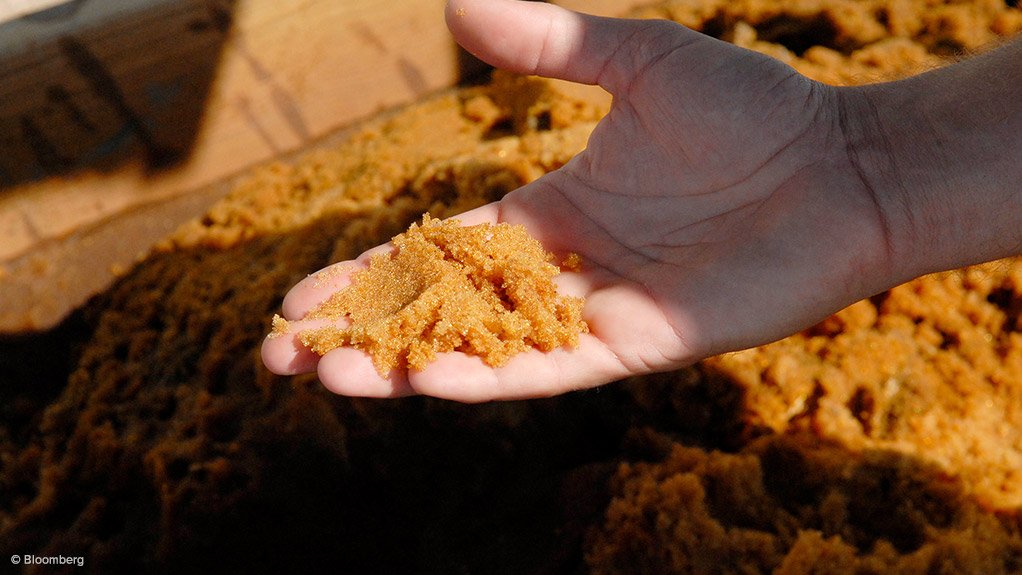VANCOUVER (miningweekly.com) – Canada’s largest uranium producer Cameco has reported a disappointing third-quarter loss for the three months ended September, prompting investors to punish the TSX-listed stock and pushing it 13% lower in early trading on Friday.
The Saskatoon, Saskatchewan-based company, swung to a headline loss of C$50-million, or C$0.13 a share, missing average Bay Street analyst forecasts calling for earnings of C$0.05 a share, and significantly lower than the C$118-million, or C$0.30 a share, profit recorded in the comparable period a year earlier.
Net earnings amounted to C$124-million, or C$0.31 a share, down from earning C$142-million, or C$0.36 a share, in the same quarter of 2016.
Revenue fell 27% year-on-year to C$486-million, as lower uranium sales, which accounted for 79% of revenue, weighed on the top line.
Cameco said it continues to expect headline earnings for the current quarter to be weaker than in 2016, despite cash from operations forecast to climb higher in 2017 than the C$312-million reported in 2016.
Cameco lowered its uranium production guidance 5% to 24-million pounds, against the 25.2-million pounds forecast previously, as a result of production delays at Key Lake caused by work required on the existing calciner circuit and lower-than-expected output at Smith Ranch-Highland .
Given its inventory position, Cameco did not rule out further production cuts should market conditions not improve.
CEO Tim Gitzel lamented the sideways nature of the uranium market over the last several quarters, saying Cameco’s third-quarter results were expected and reflect a “very deliberate strategy to strengthen the company in the long term”.
“We can’t control the timing of a market recovery, so we continue to focus on our tier-one strategy; on being as streamlined and efficient as possible; responsibly managing our production, inventory and purchases; protecting and extending the value of our contract portfolio; and maximising cash flow while maintaining our investment-grade rating. Ultimately, our goal is to remain competitive and to position the company to ensure we have the ability to be among the first to respond when the market calls for more uranium,” Gitzel stated in the company’s earnings report.
However, Cameco now expects to sell more uranium, between the 32-million-pound and 33-million-pound range, up from 30-million pounds to 32-million pounds previously, as a consequence of some contract optimisation opportunities, whereby some deliveries have been accelerated into 2017.
The miner now calls for an annual average realised price of C$47.50/lb of uranium, down from C$49/lb previously, as a result of the revised US dollar exchange rate assumption of 1.25 (previously 1.30).
Cameco advised that its Canadian dollar realised price for the first nine months of 2017 was $44.86/lb, which translates to an expectation of higher prices on deliveries in the fourth quarter.
Average unit cost of sales in the uranium segment are now expected to be $35/lb to $36/lb, down from C$36/lb to C$38/lb previously.
Uranium production volumes in the third quarter were 47% lower year-on-year at 3.1-million pounds, mainly owing to lower output from McArthur River/Key Lake and Cigar Lake, as planned maintenance and vacation shutdowns interfered with production plans.
Total debt stood at C$1.5-billion, flat from the comparable period a year earlier.
SIDEWAYS MARKET
According to Cameco, industry consultants now estimate that utilities’ cumulative uncovered requirements total over 600-million pounds over the next decade. This is lower than the previous estimate of 800-million pounds and evidence of some limited contracting activity, delays in construction programmes, early reactor retirements and project cancellations.
While some of these requirements should return as delayed reactor construction is completed, it is beyond the 2026 timeframe. As yearly supply adjusts and uncovered requirements grow, Cameco said it believes the pounds available in the spot market will not be enough to satisfy the demand.
The miner believes that the need to eventually contract for replacement volumes to fill these uncovered requirements will create opportunities for producers that can weather today’s low prices and provide a recovering market with uncommitted uranium from long-lived, tier-one assets.
On the spot market, where purchases call for delivery within one year, the volume reported by Ux Consulting for the third quarter was about 12-million pounds, which is on par with the third quarter of 2016. Year to date, about 34-million pounds had been transacted in the spot market, compared with 31-million pounds in the first three quarters of 2016.
At the end of the quarter, the average reported spot price was $20.33/lb, up $0.18 from the previous quarter.
Long-term contracts usually call for deliveries to begin more than two years after the contract is signed, and use a number of pricing formulas, including fixed prices escalated over the term of the contract, and market referenced prices (spot and long-term indicators) quoted near the time of delivery.
The volume of long-term contracting reported by UxC for the first nine months of 2017 was about 63-million pounds. Despite being higher than the 38-million pounds reported over the same period in 2016, the volumes were still less than the quantities consumed, and remained mainly discretionary owing to currently high inventory levels. The average reported long-term price at the end of the quarter was $30.50/lb, down $2.50/lb from last quarter.
Cameco's TSX-listed stock fell as low as C$9.90 a share – a new 52-week low – before recovering some ground to the C$10.51 level.
Edited by: Samantha Herbst
Creamer Media Deputy Editor
EMAIL THIS ARTICLE SAVE THIS ARTICLE
ARTICLE ENQUIRY
To subscribe email subscriptions@creamermedia.co.za or click here
To advertise email advertising@creamermedia.co.za or click here













